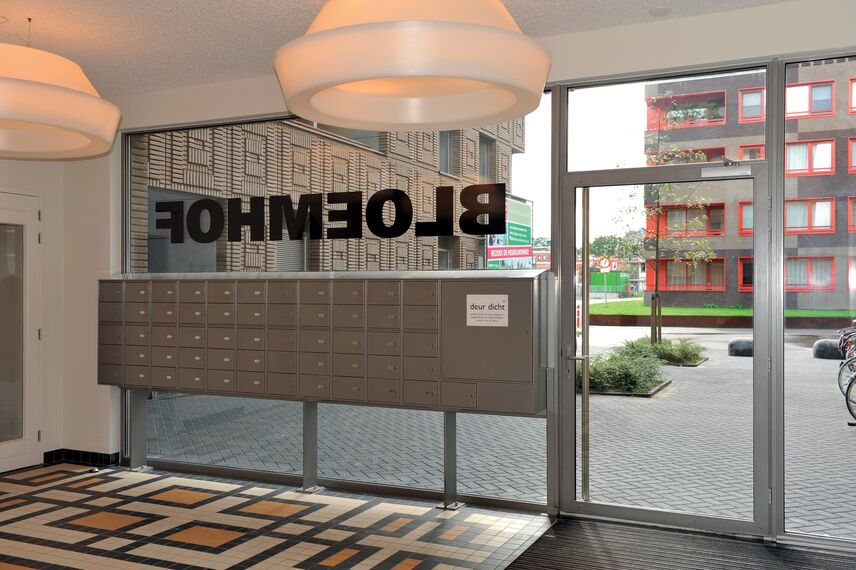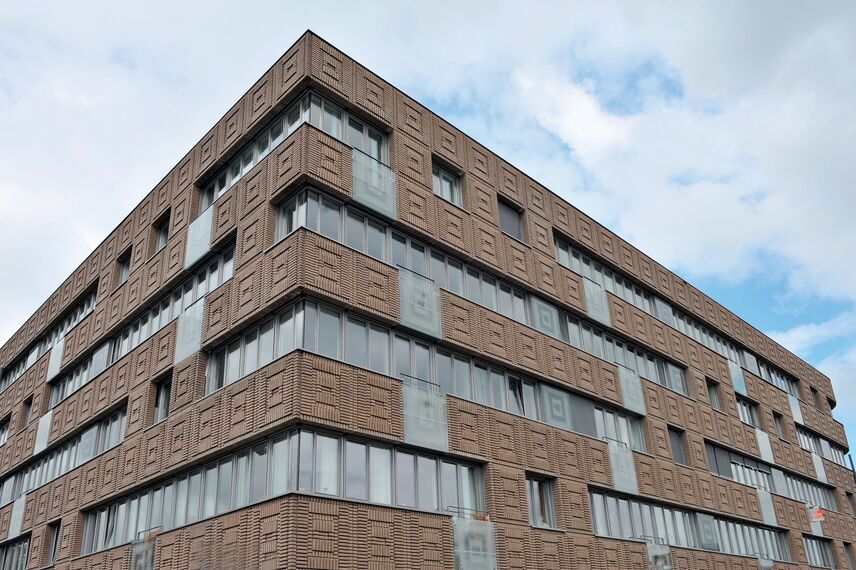- Marlies Rohmer Architecture & Urbanism
Bloemhof
After a period in which buildings in the Netherlands were primarily constructed in outlying areas outside cities, in the last few years the focus has shifted to construction in urban areas. 39% of the proposed construction at urban locations that was built in the decade between 1995 and 2005 (in this decade a very large number of VINE X neighbourhoods, named after the policy briefing released in 1988 by the Dutch Ministry of Housing, Spatial Planning and the Environment), were built on the edges of cities. These days almost all the construction activity consists of ‘condensing’. The goal is to preserve the green suburban areas and encourage the middle class to live in the city.
‘The intense city,’ a residential-building manifestation with a number of locations which are condensing and systematically enriching the Groningen city centre, is a typical example of this spatial strategy in which ‘holes’ in the urban fabric are being filled in. The Bloemhof project is part of this manifestation. The building, containing 56 starter residences and 1450 m² of commercial space, is located on the former water company property on the Bloemensingel-street.

For Bloemhof, special brick façade elements were designed with a relief pattern, evoking the same feeling of lavishness as buildings from the 19th and early 20th centuries
‘We’ve tried to work within the cacophony of buildings which determine the context to find a connection with the nearby transformer station,’ says architect Marlies Rohmer. ‘By keeping our block at a bit of a distance, we respect the monument, while at the same time we have used the ornamented brick façades to achieve the same timeless effect.’ But Rohmer very specifically did not want to recreate a historic building. ‘I do believe that a building’s construction period should be evident. The different time periods are what make a city interesting. That’s also why we chose aluminium frames, because they create a sleek and modern appearance and contrast nicely with the rather coarse façade elements.
Maarten Schmitt, the urban developer involved in the project, provided the theme ‘The parochial space,’ referring to semi-public spaces which are conceived as mediators between the many high-density residences with limited private outdoor space and the city’s green public spaces. As Rohmer explains, ‘We conceptualized that theme as a square between the monument and the new construction, an entrance area with a tree and a bench which functions as a meeting point between the residents of the building and those of the surrounding area.’ This square is further connected to the collective internal space around which the residences are grouped. In addition, the entire glass plinth ible column structure has been designed for the ground floor on a pattern of 8.10-m construction width. The residences above have the same generous proportions and can be otherwise laid out as desired. All the rooms have been given a generous ceiling height, allowing the building to be easily used for working, living, and recreational purposes.
Rohmer emphasises that flexibility is not the only thing that makes a building long-lasting. ‘In architecture, we look for a specific quality and a certain opulence, like you see in old buildings. But we do it in a contemporary way. It used to be that labour was cheap and materials were expensive, and now it’s the other way around.’ For these reasons the architect likes to work of the building, in which a large commercial space has been constructed, also functions as an intermediary between the building and the city.

The Bloemhof building is situated on the site of a former water company's premises
Anchoring the building in the city is an important theme in Marlies Rohmer’s work. One way to realise this is by designing a generic structure which can be easily adapted to various functions over time. For this reason a flexwith prefabricated materials which are often developed specifically for a particular project. For Bloemhof, special brick façade elements were designed with a relief pattern, evoking the same feeling of lavishness as buildings from the 19th and early 20th centuries. The architect chose to work with the Reynaers window system CS 38-SL because of its particularly narrow profile which is beveled on the outside. What’s unusual is that this profile has been used throughout the building, including on the entrance façade, which is 3.5 metres high. Rohmer says, ‘At first the measurements seemed too robust for working with such a narrow profile. But the Reynaers project advisor studied the stability and sturdiness, and as a result we were able to achieve the slender appearance that we wanted everywhere’.
‘The intense city’
After a period in which buildings in the Netherlands were primarily constructed in outlying areas outside cities, in the last few years the focus has shifted to construction in urban areas. 39% of the proposed construction at urban locations that was built in the decade between 1995 and 2005 (in this decade a very large number of VINE X neighbourhoods, named after the policy briefing released in 1988 by the Dutch Ministry of Housing, Spatial Planning and the Environment), were built on the edges of cities. These days almost all the construction activity consists of ‘condensing’. The goal is to preserve the green suburban areas and encourage the middle class to live in the city.
‘The intense city,’ a residential-building manifestation with a number of locations which are condensing and systematically enriching the Groningen city centre, is a typical example of this spatial strategy in which ‘holes’ in the urban fabric are being filled in. The Bloemhof project is part of this manifestation. The building, containing 56 starter residences and 1450 m² of commercial space, is located on the former water company property on the Bloemensingel street.
‘We’ve tried to work within the cacophony of buildings which determine the context to find a connection with the nearby transformer station,’ says architect Marlies Rohmer. ‘By keeping our block at a bit of a distance, we respect the monument, while at the same time we have used the ornamented brick façades to achieve the same timeless effect.’ But Rohmer very specifically did not want to recreate a historic building. ‘I do believe that a building’s construction period should be evident. The different time periods are what make a city interesting. That’s also why we chose aluminium frames, because they create a sleek and modern appearance and contrast nicely with the rather coarse façade elements. Maarten Schmitt, the urban developer involved in the project, provided the theme ‘The parochial space,’ referring to semi-public spaces which are conceived as mediators between the many high-density residences with limited private outdoor space and the city’s green public spaces. As Rohmer explains, ‘We conceptualized that theme as a square between the monument and the new construction, an entrance area with a tree and a bench which functions as a meeting point between the residents of the building and those of the surrounding area.’ This square is further connected to the collective internal space around which the residences are grouped. In addition, the entire glass plinth ible column structure has been designed for the ground floor on a pattern of 8.10-m construction width. The residences above have the same generous proportions and can be otherwise laid out as desired. All the rooms have been given a generous ceiling height, allowing the building to be easily used for working, living, and recreational purposes.
Rohmer emphasises that flexibility is not the only thing that makes a building long-lasting. ‘In architecture, we look for a specific quality and a certain opulence, like you see in old buildings. But we do it in a contemporary way. It used to be that labour was cheap and materials were expensive, and now it’s the other way around.’ For these reasons the architect likes to work of the building, in which a large commercial space has been constructed, also functions as an intermediary between the building and the city.
Anchoring the building in the city is an important theme in Marlies Rohmer’s work. One way to realise this is by designing a generic structure which can be easily adapted to various functions over time. For this reason a flexwith prefabricated materials which are often developed specifically for a particular project. For Bloemhof, special brick façade elements were designed with a relief pattern, evoking the same feeling of lavishness as buildings from the 19th and early 20th centuries. The architect chose to work with the Reynaers window system CS 38-SL because of its particularly narrow profile which is beveled on the outside. What’s unusual is that this profile has been used throughout the building, including on the entrance façade, which is 3.5 metres high. Rohmer says, ‘At first the measurements seemed too robust for working with such a narrow profile. But the Reynaers project advisor studied the stability and sturdiness, and as a result we were able to achieve the slender appearance that we wanted everywhere’.
Used systems
- CS 38-SL
- CS 38-SL
Involved stakeholders
Architect
- Marlies Rohmer Architecture & Urbanism
Fabricator
- De Haan Westerhoff Geveltechniek B.V.
Photographer
- Wim Tholenaars
- René de Wit
Other stakeholder
- Friso Bouwgroep (General contractors)
- Kirsten Hannema (Authors)






